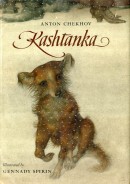 My sister, who has a four-year-old son, recently asked me if I ever feature sites about children’s books on The Second Pass, and mentioned Curious Pages in particular. I don’t often point to books for children, but I did, in fact, write about Curious Pages earlier this year. And my sister’s question about it sent me back for a look around. It’s a terrific place, which I’m adding to the Links page, and it currently features a guest review by George Saunders, who writes about Kashtanka
My sister, who has a four-year-old son, recently asked me if I ever feature sites about children’s books on The Second Pass, and mentioned Curious Pages in particular. I don’t often point to books for children, but I did, in fact, write about Curious Pages earlier this year. And my sister’s question about it sent me back for a look around. It’s a terrific place, which I’m adding to the Links page, and it currently features a guest review by George Saunders, who writes about Kashtanka by Anton Chekhov and illustrated by Gennady Spirin:
The story is simple: a dog gets lost, adjusts to her new home, is found by her old owners, goes happily back home. Like so much of Chekhov’s best work, it has the pace and emotional range of real life: no great villains, no great heroes, everybody trying to do his or her best. Neither master is an abusive brute. The dog is a small but pleasant part of both their lives. The first master is a woodcarver. The second trains domestic animals for a small-time circus act. . . .
There is essentially no real drama. The dog will be fine either way, we sense. She is not traumatized by being lost — the way a dog would be in a lesser story, in which the writer would feel more compelled to anthropomorphize her — but adjusts quickly to the world in which she finds herself. Mostly, she smells things. There aren’t any bad smells, just less-interesting ones. Likewise, when her old owners come to the circus and reclaim her, she goes along happily, and by the time they reach home, she has all but forgotten her time with the circus, which “seemed no more than a long and confusing dream.”
Kashtanka is, it seems to me, the most accurately drawn dog in literature.

